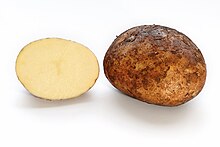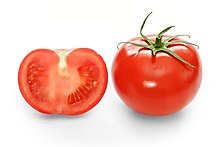Most of the food items which define modern North Indian and Subcontinental cooking have origins inside the Indian subcontinent though many foods that are now a part of them are based on fruits and vegetables that originated outside the Indian subcontinent.




Vegetable origins
| Vegetable | Hindi name | Tamil name | Telugu name | Kannada name | Origin | Likely time of introduction | Notes |
|---|---|---|---|---|---|---|---|
| Bitter Melon | karela | Paavarkai | Kaakara kaaya | Haagalu kaayi | Africa[1] | ||
| Cabbage | Patta Gobhi | Muṭṭaikkōs | Ele koosu | Possibly European | During colonial times[2] | Derived from Wild Mustard | |
| Calabash | Lauki/Pankaj | Curaikkāy | Anapukaya,sorakaya | Sore kaayi | China/Japan[3] | ||
| Cauliflower | Phool Gobhi | kosu puvvu | Hoo kosu | Cyprus[4][5] | 1822 CE[6] | ||
| Chili pepper | Mirch | Miḷakāy | mirapakaya | Menasina kaayi | Mesoamerica [7] | 1550 CE[7] | india |
| Coriander | Dhaniya | Kottamalli | kotthimeera | Kothamari soppu | North Africa [8] or Mediterranean | 1000 AD [9] by Arabs | Mentioned in ancient Egypt |
| Brinjal | Baingan | Kattirikkāy | vankaya | Badane kaayi | India/China[10] | ||
| Fenugreek | Methi | Ventayam | menthi koora | Menthya | Near East [11] | 326 BC [12] | Alexander's campaign to India |
| Garlic | Lahsoon | Pūṇṭu | Velluli/Elligadda | Belluli | possibly Middle East [13] | Unknown | |
| Lemon | Neembú | Elumiccai | nimmakaya | Nimbe hannu | South China or Northeastern India[14] | 2000-1000 BC[14] | Lemon seeds found in the Harappan Bara culture excavations indicate time of spread[14] |
| Moringa | Muruṅkai | Munakkaada | Nugge kaayi | India | |||
| Okra | Bhindi | Veṇṭaikkāy | Bendakaaya | Bende kaayi | Highlands of Ethiopia and india[15] | 100-500 CE[15] | |
| Onion | Pyaaz | Veṅkāyam | Ulligadda,ullipaya,erragadda | Eerulli | India [citation needed] | Unknown, but present by 500 BCE[16] | Mentioned in the Charaka Samhita |
| Potato | Aloo | Uruḷaikkiḻaṅku | Bangala Dumpa/Aloo Gadda | Aloo gadde | South America (Peru/Bolivia) [17] | 1600 CE | Likely introduced by Portuguese traders |
| Sweet Potato | Shakarkand | Iṉippu uruḷaikkiḻaṅku | Chilagada dumpa | Sihi genasu | South America [18] | 1600 CE) | Via Portugal |
| Taro | Arbi / Arwi/ Guhiyaan | Seppankizhangu | Chaamadumpa, chaamagadda | Unknown (India, Polynesia or SE Asia) | Unknown | ||
| Tomato | Tamatar | Takkāḷi | Tamata / rama phalam | Goode hannu | Latin America (Mexico to Peru) [19] | 1600 CE | Likely introduced by Portuguese traders |
| Turnip | Shalgham | Ṭarṉip | Gedde kosu | West Asia or Eastern Europe [citation needed] | 1500 BC | Very early presence in the South Asia | |
| Yam | Zimikand/Suran/kachalu/banda | Karunai kizhangu | Kanda | Genasu | Africa/Asia [citation needed] | 7000 BCE | Different types of yams by taste, colour, size, skin, acidity |
Fruit origins
| Fruit | Hindi Name | Telugu Name | Tamil Name | Origin | Likely time of introduction | Notes |
|---|---|---|---|---|---|---|
| Apple | Seb | Āppiḷ | Central Asia (Kazakhstan) [20] | Unknown | ||
| Mango | Aam | Mamidi Pandu | Māṅkaṉi | India | Unknown | Mango is mentioned by Hendrik van Rheede, the Dutch commander of the Malabar region in his 1678 book |
| Mulberry | Shehtoot/Toot | Malperi | China/Japan | Unknown | Its white type is toxic whereas red is very sweet | |
| Orange | Santara [citation needed] | Kamalapandu | Ārañcu | India | Unknown | A sweeter Indian variety was introduced by the Portuguese in Europe (ca. 15th century) |
| Plum | Aloo Bokhara | Piḷam | Armenia | Unknown | ||
| Tamarind | Hunase Hannu/ Imli | Chintakaya/Chintapandu | Puḷi | Africa | Unknown | Known for savourish taste, the fruit has mention since Harappan times |
| Tangerine | Narangi | Narinja Pandu | Ṭēṅkariṉ | China | Unknown |
See also
References
Further reading
- "Domestication of plants in the Old World," Daniel Zohary and Maria Hopf, Oxford University Press, 2000.
- "History of Food," Maguelonne Toussaint-Samat, Blackwell Publishing, 1994.
- "Culture and Cuisine: A Journey Through the History of Food," Jean François Revel, Doubleday, 1982.
- "The Agrarian History of England and Wales," Edward John T. Collins, Stuart Piggott, Joan Thirsk, Cambridge University Press, 1981.
🔥 Top keywords: Main PageSpecial:SearchPage 3Wikipedia:Featured picturesHouse of the DragonUEFA Euro 2024Bryson DeChambeauJuneteenthInside Out 2Eid al-AdhaCleopatraDeaths in 2024Merrily We Roll Along (musical)Jonathan GroffJude Bellingham.xxx77th Tony AwardsBridgertonGary PlauchéKylian MbappéDaniel RadcliffeUEFA European Championship2024 ICC Men's T20 World CupUnit 731The Boys (TV series)Rory McIlroyN'Golo KantéUEFA Euro 2020YouTubeRomelu LukakuOpinion polling for the 2024 United Kingdom general electionThe Boys season 4Romania national football teamNicola CoughlanStereophonic (play)Gene WilderErin DarkeAntoine GriezmannProject 2025

